Determinants Affecting Purchase Willingness of Contractors towards Construction and Demolition Waste Recycling Products: An Empirical Study in Shenzhen, China
Abstract
1. Introduction
2. Theoretical Basis and Research Hypotheses
2.1. Theory of Planned Behavior
2.2. Perceived Consumer Effectiveness
2.3. Recycled Product Information
2.4. Government Measures
3. Research Methods and Process
3.1. Identifying Potential Influencing Factors
3.2. Collecting Quantitative Data
3.2.1. Preliminary Questionnaire
3.2.2. Final Questionnaire
3.2.3. Questionnaire Distribution and Collection
3.2.4. Respondents’ Information
3.3. Analyzing the Quantitative Data
3.4. Verifying and Discussing Determinants
4. Results
4.1. Reliability Analysis
4.2. Confirmatory Factor Analysis
4.3. Multiple Regression Analysis
5. Discussions
5.1. The Critical Influencing Factors
5.1.1. Government Measures
5.1.2. Purchase Attitude
5.1.3. Perceived Behavioral Control
5.1.4. Subjective Norms
5.1.5. Perceived Consumer Effectiveness
5.1.6. Recycled Product Information
5.2. Strategies for Increasing Purchase Willingness of Recycled C&DW Products
5.2.1. Strategies for Government
5.2.2. Strategies for Contractors
5.2.3. Strategies for Recycling Enterprises
5.2.4. Strategies for Public Buyers
6. Conclusions
Author Contributions
Funding
Institutional Review Board Statement
Informed Consent Statement
Data Availability Statement
Acknowledgments
Conflicts of Interest
References
- Zheng, L.; Wu, H.; Zhang, H.; Duan, H.; Wang, J.; Jiang, W.; Dong, B.; Liu, G.; Zuo, J.; Song, Q. Characterizing the generation and flows of construction and demolition waste in China. Constr. Build. Mater. 2017, 136, 405–413. [Google Scholar] [CrossRef]
- Yu, B.; Wang, J.; Li, J.; Zhang, J.; Lai, Y.; Xu, X. Prediction of large-scale demolition waste generation during urban renewal: A hybrid trilogy method. Waste Manag. 2019, 89, 1–9. [Google Scholar] [CrossRef] [PubMed]
- Alwan, Z.; Jones, P.; Holgate, P. Strategic sustainable development in the UK construction industry, through the framework for strategic sustainable development, using Building Information Modelling. J. Clean. Prod. 2017, 140, 349–358. [Google Scholar] [CrossRef]
- Wu, H.; Zuo, J.; Yuan, H.; Zillante, G.; Wang, J. A review of performance assessment methods for construction and demolition waste management. Resour. Conserv. Recycl. 2019, 150, 104407. [Google Scholar] [CrossRef]
- Wu, H.; Zuo, J.; Yuan, H.; Zillante, G.; Wang, J. Cross-regional mobility of construction and demolition waste in Australia: An exploratory study. Resour. Conserv. Recycl. 2020, 156, 104710. [Google Scholar] [CrossRef]
- Yuan, H.; Shen, L. Trend of the research on construction and demolition waste management. Waste Manag. 2011, 31, 670–679. [Google Scholar] [CrossRef] [PubMed]
- Aslam, M.S.; Huang, B.; Cui, L. Review of construction and demolition waste management in China and USA. J. Environ. Manag. 2020, 264, 110445. [Google Scholar] [CrossRef]
- Akhtar, A.; Sarmah, A.K. Construction and demolition waste generation and properties of recycled aggregate concrete: A global perspective. J. Clean. Prod. 2018, 186, 262–281. [Google Scholar] [CrossRef]
- Galán, B.; Viguri, J.; Cifrian, E.; Dosal, E.; Andres, A. Influence of input streams on the construction and demolition waste (CDW) recycling performance of basic and advanced treatment plants. J. Clean. Prod. 2019, 236, 117523. [Google Scholar] [CrossRef]
- Santos, S.; da Silva, P.; de Brito, J. Self-compacting concrete with recycled aggregates—A literature review. J. Build. Eng. 2019, 22, 349–371. [Google Scholar] [CrossRef]
- Silva, R.; de Brito, J.; Dhir, R. Performance of cementitious renderings and masonry mortars containing recycled aggregates from construction and demolition wastes. Constr. Build. Mater. 2016, 105, 400–415. [Google Scholar] [CrossRef]
- Stefanidou, M.; Anastasiou, E.; Filikas, K.G. Recycled sand in lime-based mortars. Waste Manag. 2014, 34, 2595–2602. [Google Scholar] [CrossRef]
- Yu, B.; Wang, J.; Li, J.; Lu, W.; Li, C.Z.; Xu, X. Quantifying the potential of recycling demolition waste generated from urban renewal: A case study in Shenzhen, China. J. Clean. Prod. 2020, 247, 119127. [Google Scholar] [CrossRef]
- Al-Bayati, H.K.A.; Tighe, S.L.; Achebe, J. Influence of recycled concrete aggregate on volumetric properties of hot mix asphalt. Resour. Conserv. Recycl. 2018, 130, 200–214. [Google Scholar] [CrossRef]
- Kumar, R. Influence of recycled coarse aggregate derived from construction and demolition waste (CDW) on abrasion resistance of pavement concrete. Constr. Build. Mater. 2017, 142, 248–255. [Google Scholar] [CrossRef]
- Xuan, D.X.; Molenaar, A.A.A.; Houben, L.J.M. Shrinkage cracking of cement treated demolition waste as a road base. Mater. Struct. 2015, 49, 631–640. [Google Scholar] [CrossRef]
- He, L.; Yuan, H. Investigation of construction waste recycling decisions by considering consumers’ quality perceptions. J. Clean. Prod. 2020, 259, 120928. [Google Scholar] [CrossRef]
- Li, J.; Zuo, J.; Cai, H.; Zillante, G. Construction waste reduction behavior of contractor employees: An extended theory of planned behavior model approach. J. Clean. Prod. 2018, 172, 1399–1408. [Google Scholar] [CrossRef]
- Wu, Z.; Yu, A.T.; Shen, L. Investigating the determinants of contractor’s construction and demolition waste management behavior in Mainland China. Waste Manag. 2017, 60, 290–300. [Google Scholar] [CrossRef]
- Li, J.; Tam, V.W.; Zuo, J.; Zhu, J. Designers’ attitude and behaviour towards construction waste minimization by design: A study in Shenzhen, China. Resour. Conserv. Recycl. 2015, 105, 29–35. [Google Scholar] [CrossRef]
- Wang, J.; Yu, B.; Tam, V.W.; Li, J.; Xu, X. Critical factors affecting willingness of design units towards construction waste minimization: An empirical study in Shenzhen, China. J. Clean. Prod. 2019, 221, 526–535. [Google Scholar] [CrossRef]
- Bakshan, A.; Srour, I.; Chehab, G.; El-Fadel, M.; Karaziwan, J. Behavioral determinants towards enhancing construction waste management: A Bayesian Network analysis. Resour. Conserv. Recycl. 2017, 117, 274–284. [Google Scholar] [CrossRef]
- Liu, J.; Gong, E.; Wang, D.; Lai, X.; Zhu, J. Attitudes and behaviour towards construction waste minimisation: A comparative analysis between China and the USA. Environ. Sci. Pollut. Res. 2019, 26, 13681–13690. [Google Scholar] [CrossRef]
- Mak, T.M.; Yu, I.K.; Wang, L.; Hsu, S.-C.; Tsang, D.C.; Li, C.; Yeung, T.L.; Zhang, R.; Poon, C.S. Extended theory of planned behaviour for promoting construction waste recycling in Hong Kong. Waste Manag. 2019, 83, 161–170. [Google Scholar] [CrossRef] [PubMed]
- Udawatta, N.; Zuo, J.; Chiveralls, K.; Zillante, G. Attitudinal and behavioral approaches to improving waste management on construction projects in Australia: Benefits and limitations. Int. J. Constr. Manag. 2015, 15, 137–147. [Google Scholar]
- Yuan, H.; Wu, H.; Zuo, J. Understanding Factors Influencing Project Managers’ Behavioral Intentions to Reduce Waste in Construction Projects. J. Manag. Eng. 2018, 34, 04018031. [Google Scholar] [CrossRef]
- Ajzen, I. From Intentions to Actions: A Theory of Planned Behavior. Organ. Behave Decis. Process. 1991, 50, 179–211. [Google Scholar] [CrossRef]
- Echegaray, F.; Hansstein, F.V. Assessing the intention-behavior gap in electronic waste recycling: The case of Brazil. J. Clean. Prod. 2017, 142, 180–190. [Google Scholar] [CrossRef]
- Wang, B.; Ren, C.; Dong, X.; Zhang, B.; Wang, Z. Determinants shaping willingness towards on-line recycling behaviour: An empirical study of household e-waste recycling in China. Resour. Conserv. Recycl. 2019, 143, 218–225. [Google Scholar] [CrossRef]
- Chan, L.; Bishop, B. A moral basis for recycling: Extending the theory of planned behaviour. J. Environ. Psychol. 2013, 36, 96–102. [Google Scholar] [CrossRef]
- Berger, I.E.; Corbin, R.M. Perceived consumer effectiveness and faith in others as moderators of environmentally responsible behaviors. J. Public Policy Mark. 1992, 11, 79–89. [Google Scholar] [CrossRef]
- Higueras-Castillo, E.; Liébana-Cabanillas, F.J.; Muñoz-Leiva, F.; García-Maroto, I. Evaluating consumer attitudes toward electromobility and the moderating effect of perceived consumer effectiveness. J. Retail. Consum. Serv. 2019, 51, 387–398. [Google Scholar] [CrossRef]
- Cho, Y.-N.; Thyroff, A.; Rapert, M.I.; Park, S.-Y.; Lee, H.J. To be or not to be green: Exploring individualism and collectivism as antecedents of environmental behavior. J. Bus. Res. 2013, 66, 1052–1059. [Google Scholar] [CrossRef]
- Lee, Y.-K.; Kim, S.; Kim, M.-S.; Choi, J.-G. Antecedents and interrelationships of three types of pro-environmental behavior. J. Bus. Res. 2014, 67, 2097–2105. [Google Scholar] [CrossRef]
- Roberts, J.A. Green consumers in the 1990s: Profile and implications for advertising. J. Bus. Res. 1996, 36, 217–231. [Google Scholar] [CrossRef]
- Kabadayı, E.T.; Dursun, I.; Alan, A.K.; Tuğer, A.T. Green Purchase Intention of Young Turkish Consumers: Effects of Consumer’s Guilt, Self-monitoring and Perceived Consumer Effectiveness. Procedia Soc. Behav. Sci. 2015, 207, 165–174. [Google Scholar] [CrossRef]
- Plasek, B.; Temesi, A. The credibility of the effects of functional food products and consumers’ willingness to purchase/willingness to pay–review. Appetite 2019, 143, 104398. [Google Scholar] [CrossRef] [PubMed]
- Chang, T.-Z.; Wildt, A.R. Price, Product Information, and Purchase Intention: An Empirical Study. J. Acad. Mark. Sci. 1994, 22, 16–27. [Google Scholar] [CrossRef]
- Gaur, J.; Amini, M.; Banerjee, P.; Gupta, R. Drivers of consumer purchase intentions for remanufactured products. Qual. Mark. Res. Int. J. 2015, 18, 30–47. [Google Scholar] [CrossRef]
- Ares, G.; Giménez, A.; Deliza, R. Influence of three non-sensory factors on consumer choice of functional yogurts over regular ones. Food Qual. Prefer. 2010, 21, 361–367. [Google Scholar] [CrossRef]
- Krishnan, R.; Lindsey-Mullikin, J.; Borin, N. An analysis of consumer reactions to green strategies. J. Prod. Brand Manag. 2013, 22, 118–128. [Google Scholar]
- Can, S.D.L.R.D.; Leventis, G.; Phadke, A.; Gopal, A. Design of incentive programs for accelerating penetration of energy-efficient appliances. Energy Policy 2014, 72, 56–66. [Google Scholar] [CrossRef]
- Little, A.T. Propaganda and credulity. Games Econ. Behav. 2017, 102, 224–232. [Google Scholar] [CrossRef]
- Liu, X.; Ren, H.; Wu, Y.; Kong, D. An analysis of the demonstration projects for renewable energy application buildings in China. Energy Policy 2013, 63, 382–397. [Google Scholar] [CrossRef]
- Jansson, J.; Marell, A.; Nordlund, A. Elucidating green consumers: A cluster analytic approach on pro-environmental purchase and curtailment behaviours. J. Euromarket. 2009, 18, 245–267. [Google Scholar] [CrossRef]
- Yang, S.; Zhao, D. Do subsidies work better in low-income than in high-income families? Survey on domestic energy-efficient and renewable energy equipment purchase in China. J. Clean. Prod. 2015, 108, 841–851. [Google Scholar] [CrossRef]
- Steg, L.; Vlek, C. Encouraging pro-environmental behaviour: An integrative review and research agenda. J. Environ. Psychol. 2009, 29, 309–317. [Google Scholar] [CrossRef]
- Begum, R.A.; Siwar, C.; Pereira, J.J.; Jaafar, A.H. Attitude and behavioral factors in waste management in the construction industry of Malaysia. Resour. Conserv. Recycl. 2009, 53, 321–328. [Google Scholar] [CrossRef]
- Li, J.; Zuo, J.; Wang, G.; He, G.; Tam, V.W. Stakeholders’ willingness to pay for the new construction and demolition waste landfill charge scheme in Shenzhen: A contingent valuation approach. Sustain. Cities Soc. 2020, 52, 101663. [Google Scholar] [CrossRef]
- Kline, R.B. Principles and practice of Structural Equation Modeling. J. Am. Stat. Assoc. 2011, 101, 1–14. [Google Scholar]
- Hair, J.F.; Black, W.C.; Babin, B.J.; Anderson, R.E.; Tatham, R.L. Multivariate Data Analysis; Macmillan: New York, NY, USA, 1998. [Google Scholar]
- Nunnally, J.C.; Bernstein, I.H. Psychometric Theory; McGraw-Hill: New York, NY, USA, 2007. [Google Scholar]
- Kline, R.B. Principles and Practice of Structural Equation Modeling, 4th ed.; Guilford Publications: New York, NY, USA, 2015. [Google Scholar]
- Xiong, B.; Skitmore, M.; Xia, B.; Masrom, A.; Ye, K.; Bridge, A. Examining the influence of participant performance factors on contractor satisfaction: A structural equation model. Int. J. Proj. Manag. 2014, 32, 482–491. [Google Scholar] [CrossRef]
- Xiong, B.; Skitmore, M.; Xia, B. A critical review of structural equation modeling applications in construction research. Autom. Constr. 2015, 49, 59–70. [Google Scholar] [CrossRef]
- Ajayi, S.O.; Oyedele, L.O. Critical design factors for minimising waste in construction projects: A structural equation modelling approach. Resour. Conserv. Recycl. 2018, 137, 302–313. [Google Scholar] [CrossRef]
- Chen, Y.Q.; Zhang, Y.B.; Liu, J.Y.; Mo, P. Interrelationships among Critical Success Factors of Construction Projects Based on the Structural Equation Model. J. Manag. Eng. 2012, 28, 243–251. [Google Scholar] [CrossRef]
- Zhao, T.; Bell, L.; Horner, M.W.; Sulik, J.; Zhang, J. Consumer responses towards home energy financial incentives: A survey-based study. Energy Policy 2012, 47, 291–297. [Google Scholar] [CrossRef]
- Li, Q.; Long, R.; Chen, H. Empirical study of the willingness of consumers to purchase low-carbon products by considering carbon labels: A case study. J. Clean. Prod. 2017, 161, 1237–1250. [Google Scholar] [CrossRef]
- Wang, Z.; Wang, X.; Guo, D. Policy implications of the purchasing intentions towards energy-efficient appliances among China’s urban residents: Do subsidies work? Energy Policy. 2017, 102, 430–439. [Google Scholar] [CrossRef]
- Yadav, R.; Pathak, G.S. Intention to purchase organic food among young consumers: Evidences from a developing nation. Appetite 2016, 96, 122–128. [Google Scholar] [CrossRef]
- Shuai, C.-M.; Ding, L.-P.; Zhang, Y.-K.; Guo, Q.; Shuai, J. How consumers are willing to pay for low-carbon products?—Results from a carbon-labeling scenario experiment in China. J. Clean. Prod. 2014, 83, 366–373. [Google Scholar] [CrossRef]
- Annunziata, A.; Vecchio, R. Consumer perception of functional foods: A conjoint analysis with probiotics. Food Qual. Prefer. 2013, 28, 348–355. [Google Scholar] [CrossRef]
- Gao, Y.; Yin, Y.; Li, B.; He, K.; Wang, X. Post-failure behavior analysis of the Shenzhen “12.20” construction and demolition waste landfill landslide. Waste Manag. 2019, 83, 171–183. [Google Scholar] [CrossRef] [PubMed]
- Shenzhen Housing and Construction Bureau (SHCB). Excavated Soil and Rock Exchange and C&DW Recycling Product Information Publishing Platform (in Chinese). 2018. Available online: http://jh.jzfqw.szsti.org/ (accessed on 21 April 2021).
- Yuan, H. A SWOT analysis of successful construction waste management. J. Clean. Prod. 2013, 39, 1–8. [Google Scholar] [CrossRef]
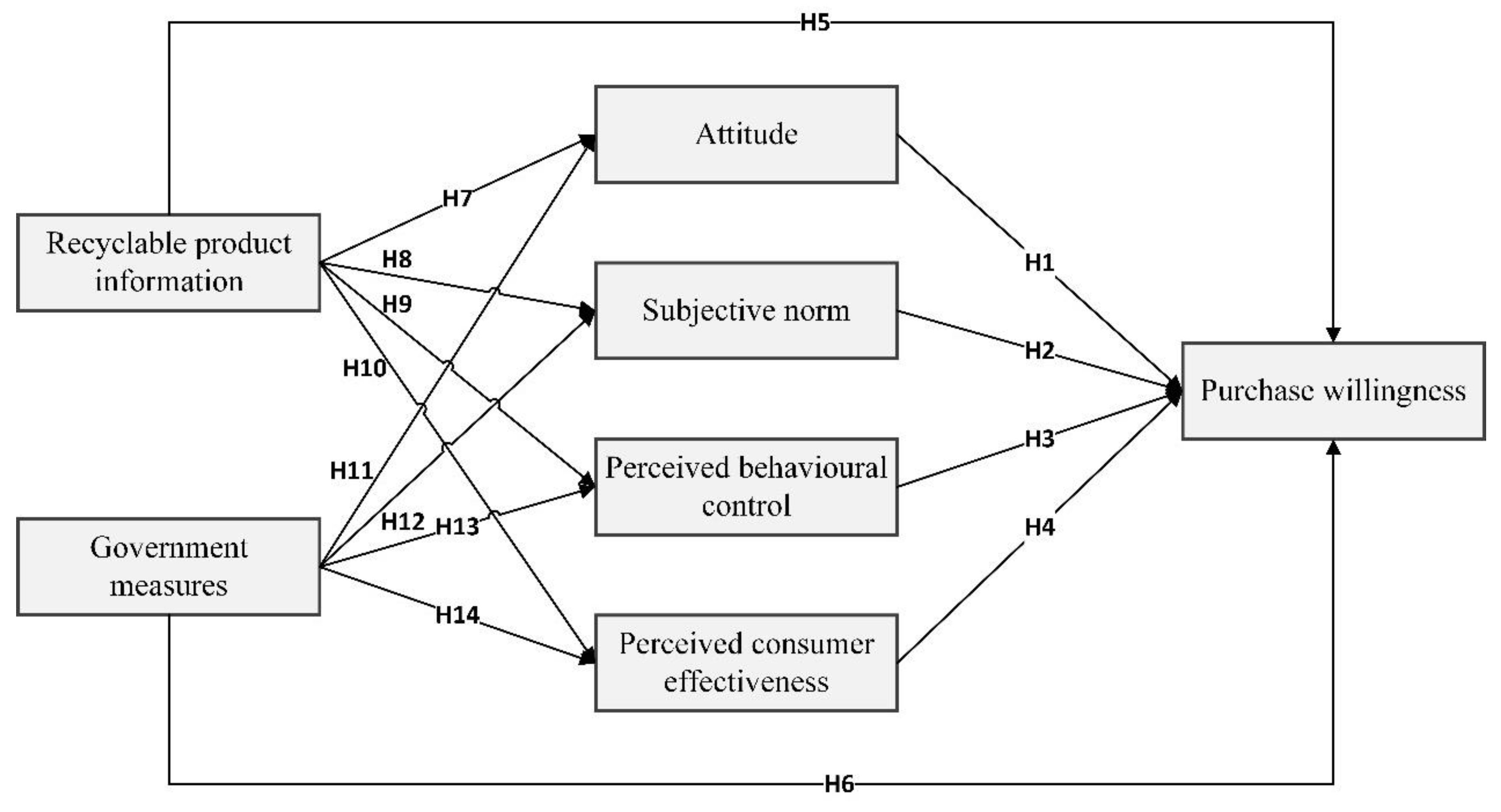
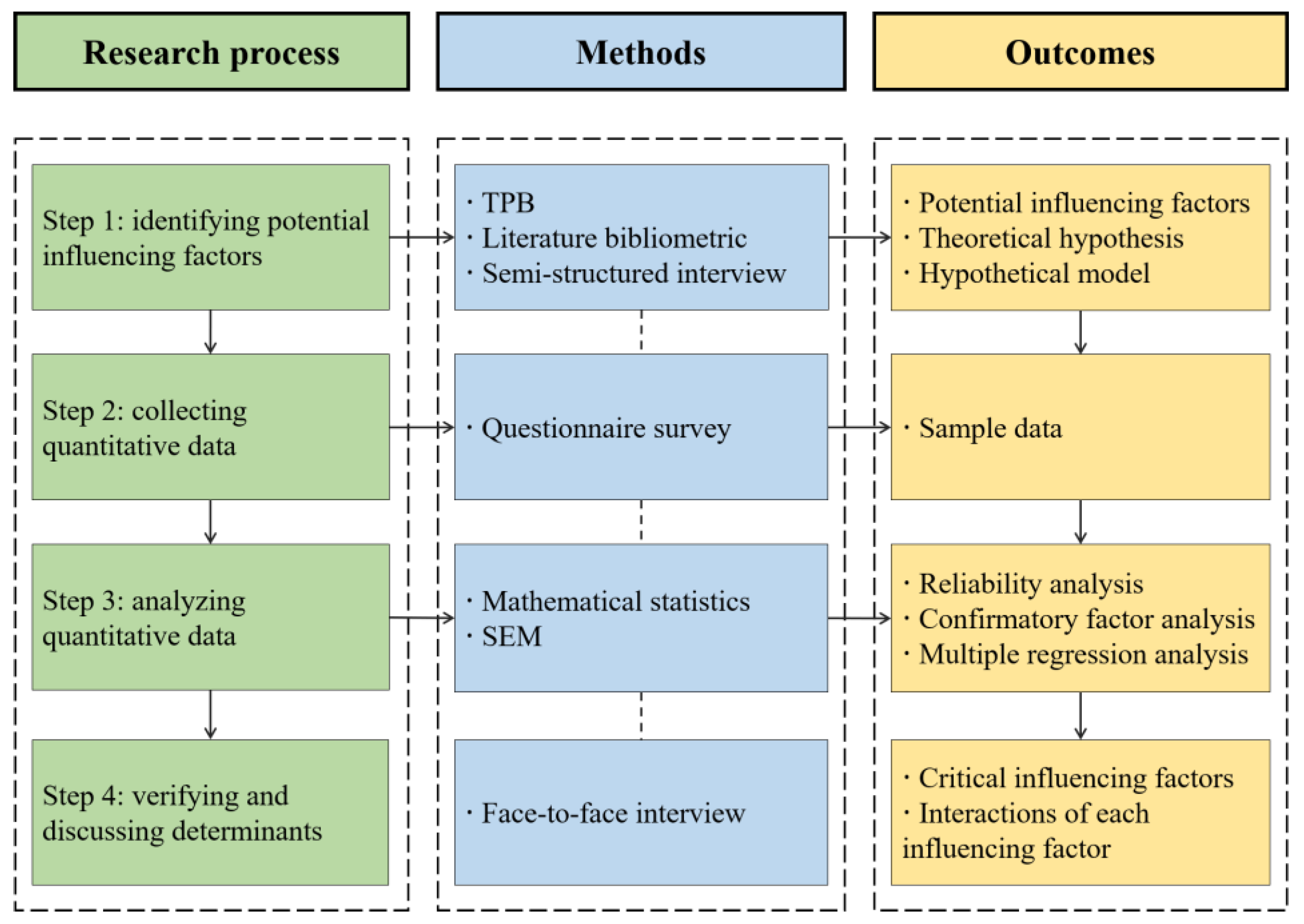
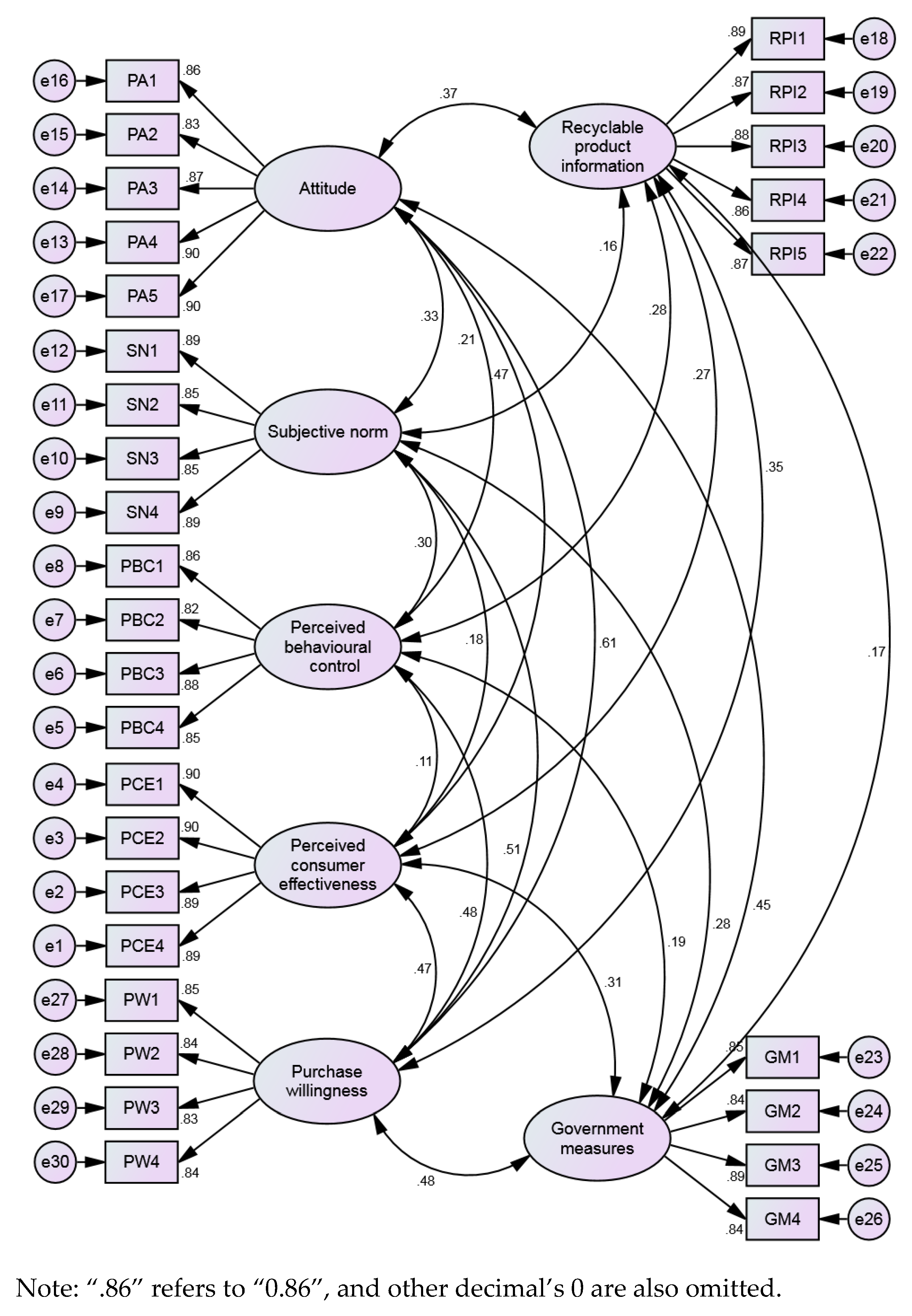
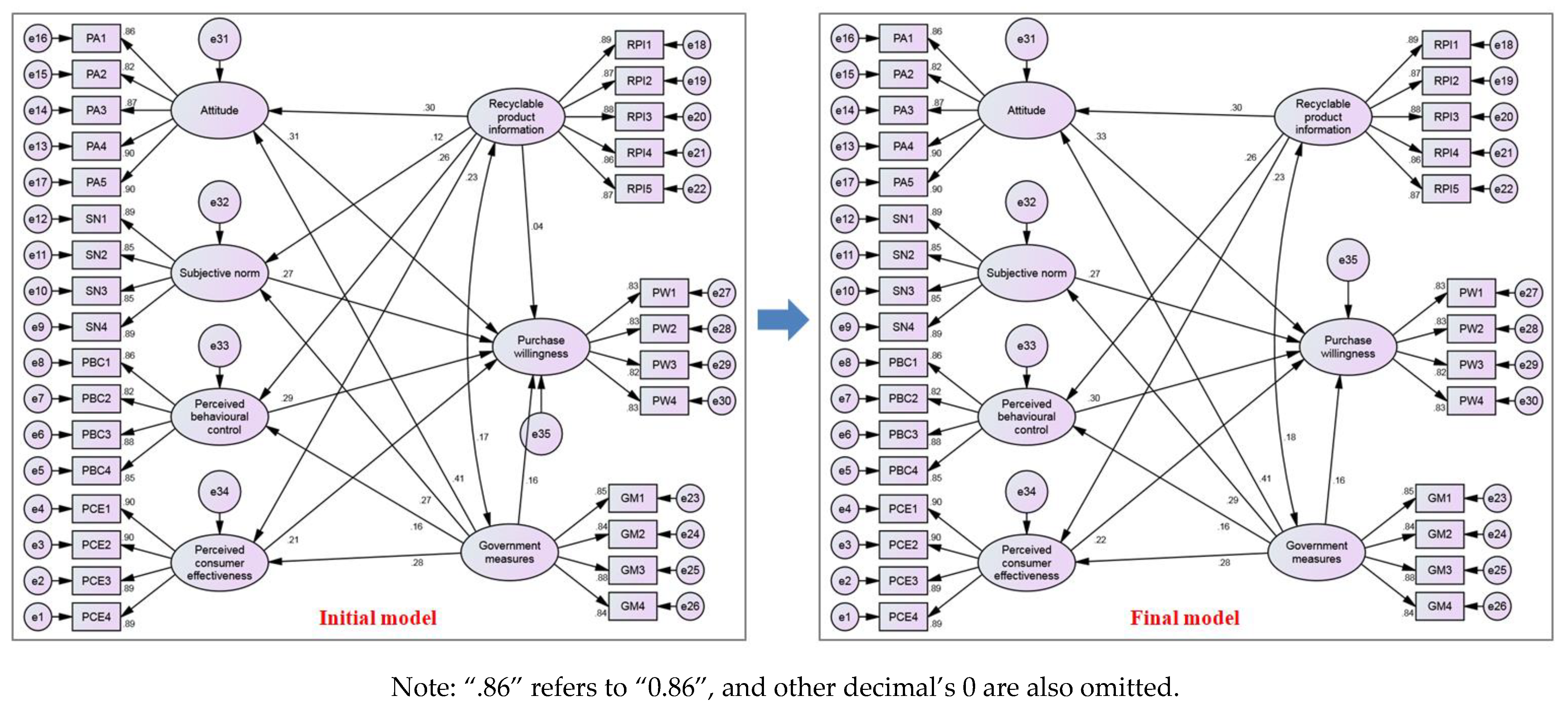
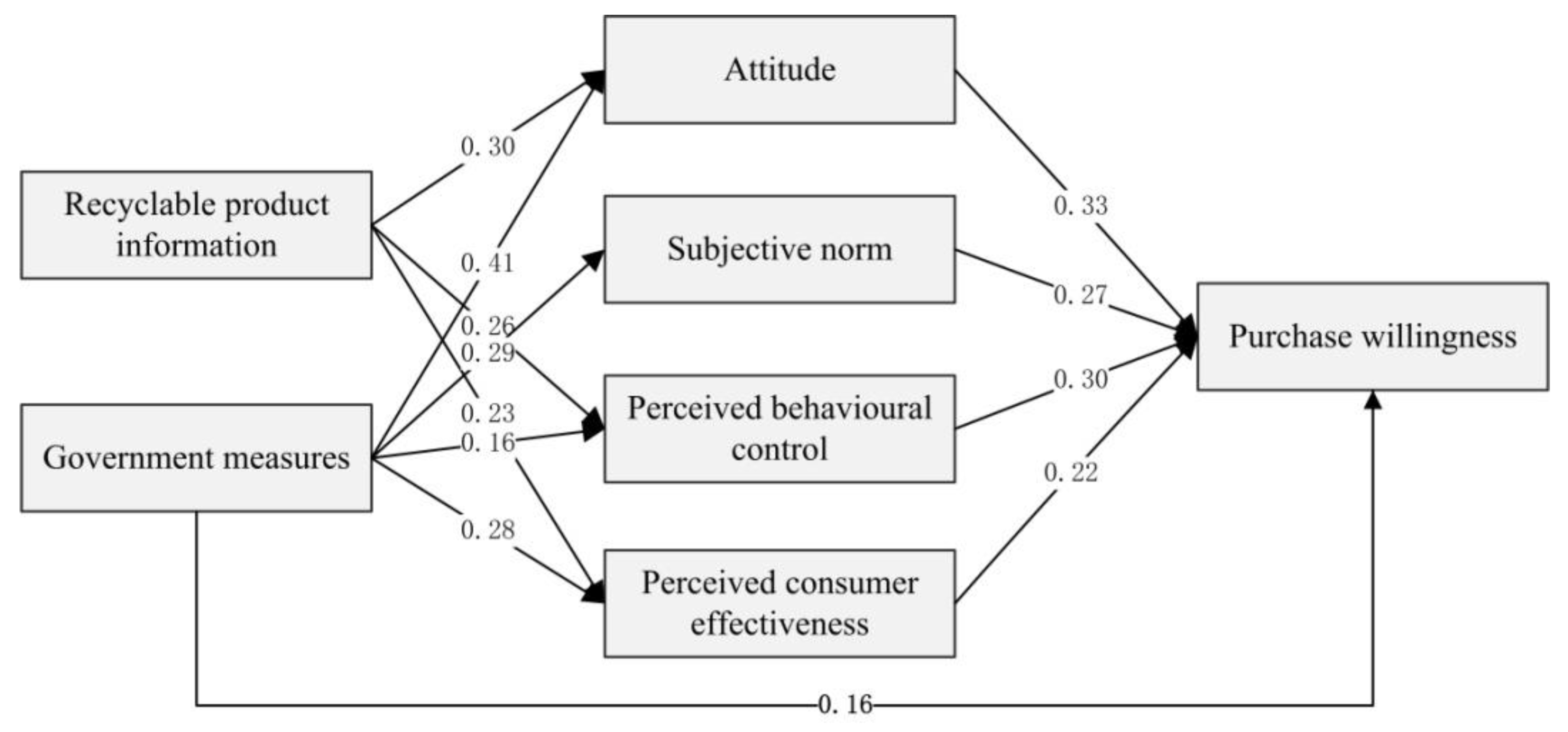
| Variable | Category | Number | Percentage (%) | |
|---|---|---|---|---|
| Personal information | Gender | Male | 379 | 96.9 |
| Female | 12 | 3.1 | ||
| Age (years old) | <35 | 13 | 3.3 | |
| 35–45 | 102 | 26.1 | ||
| 45–55 | 221 | 56.5 | ||
| >55 | 55 | 14.1 | ||
| Work experience (years) | <10 | 8 | 2.0 | |
| 10–20 | 94 | 24.0 | ||
| 20–30 | 200 | 51.2 | ||
| >30 | 89 | 22.8 | ||
| Educational level | Senior school or below | 27 | 6.9 | |
| Bachelor | 272 | 69.6 | ||
| Master or above | 92 | 23.5 | ||
| Position | Chairman | 87 | 22.3 | |
| General manager | 129 | 33.0 | ||
| Department manager | 121 | 30.9 | ||
| Project manager | 54 | 13.8 | ||
| Corporate Information | Professional field | Housing construction engineering | 127 | 32.5 |
| Municipal public engineering | 113 | 28.9 | ||
| Building decoration engineering | 67 | 17.1 | ||
| Others a | 84 | 21.5 | ||
| Qualifications level | Premium | 58 | 14.8 | |
| Level 1 | 172 | 44.0 | ||
| Level 2 | 100 | 25.6 | ||
| Level 3 | 61 | 15.6 | ||
| Registration type | State-owned enterprise | 147 | 37.6 | |
| Private enterprise | 215 | 55.0 | ||
| Others b | 29 | 7.4 | ||
| Overall Model Fit | Specific Indicators | Abbreviation |
|---|---|---|
| Absolute fit indices | Normalized chi-square | X2/df |
| Root mean square residual | RMR | |
| Goodness-of-fit index | GFI | |
| Adjusted goodness-of-fit index | AGFI | |
| Root mean square error of approximation | RMSEA | |
| Incremental fit indices | Normed fit index | NFI |
| Comparative fit index | CFI | |
| Tucker–Lewis Index | TLI | |
| Incremental fit index | IFI | |
| Relative fit index | RFI | |
| Parsimonious fit indices | Parsimony normed-fit index | PNFI |
| Parsimony comparative fit index | PCFI | |
| Parsimony goodness-of-fit index | PGFI |
| Latent Variables | Cronbach’s Alpha | Overall Cronbach’s Alpha |
|---|---|---|
| Purchase willingness | 0.903 | 0.923 |
| Purchase attitude | 0.937 | |
| Subjective norm | 0.926 | |
| Perceived behavioral control | 0.912 | |
| Perceived consumer effectiveness | 0.940 | |
| Recycled product information | 0.941 | |
| Government measures | 0.918 |
| Goodness-of-Fit Measure | Level of Acceptance Fit a | Fit Statistics | |
|---|---|---|---|
| Absolute fit | X2/df | <5 (preferably 1–2) | 1.210 |
| RMR | <0.05 | 0.034 | |
| GFI | 0–1 (no fit–perfect fit) | 0.893 | |
| AGFI | 0–1 (no fit–perfect fit) | 0.871 | |
| RMSEA | <0.10 (preferably <0.08) | 0.028 | |
| Incremental fit | NFI | 0–1 (no fit–perfect fit) | 0.934 |
| IFI | 0–1 (no fit–perfect fit) | 0.988 | |
| CFI | 0–1 (no fit–perfect fit) | 0.988 | |
| RFI | 0–1 (no fit–perfect fit) | 0.925 | |
| TLI | 0–1 (no fit–perfect fit) | 0.986 | |
| Parsimonious fit | PNFI | >0.5 | 0.824 |
| PGFI | >0.5 | 0.738 | |
| PCFI | >0.5 | 0.872 | |
| Goodness-of-Fit Measure | Level of Acceptance Fit a | Fit Statistics | ||
|---|---|---|---|---|
| Initial Model | Final Model | |||
| Absolute fit | X2/df | <5 (preferably 1–2) | 1.319 | 1.323 |
| RMR | <0.05 | 0.074 | 0.083 | |
| GFI | 0–1 (no fit–perfect fit) | 0.882 | 0.881 | |
| AGFI | 0–1 (no fit–perfect fit) | 0.859 | 0.859 | |
| RMSEA | <0.10 (preferably <0.08) | 0.035 | 0.035 | |
| Incremental fit | NFI | 0–1 (no fit–perfect fit) | 0.927 | 0.926 |
| IFI | 0–1 (no fit–perfect fit) | 0.981 | 0.981 | |
| CFI | 0–1 (no fit–perfect fit) | 0.981 | 0.981 | |
| RFI | 0–1 (no fit–perfect fit) | 0.918 | 0.918 | |
| TLI | 0–1 (no fit–perfect fit) | 0.979 | 0.979 | |
| Parsimonious fit | PNFI | >0.5 | 0.831 | 0.835 |
| PGFI | >0.5 | 0.740 | 0.743 | |
| PCFI | >0.5 | 0.880 | 0.884 | |
| Path a | Estimate | S.E. | C.R. | P | ||||
|---|---|---|---|---|---|---|---|---|
| Initial Model | Final Model | Initial Model | Final Model | Initial Model | Final Model | Initial Model | Final Model | |
| PW ← PA | 0.309 | 0.325 | 0.048 | 0.046 | 5.171 | 5.693 | *** c | *** |
| PW ← SN | 0.265 | 0.267 | 0.044 | 0.043 | 5.081 | 5.101 | *** | *** |
| PW ← PBC | 0.289 | 0.302 | 0.046 | 0.045 | 5.417 | 5.768 | *** | *** |
| PW ← PCE | 0.213 | 0.222 | 0.041 | 0.040 | 4.031 | 4.245 | *** | *** |
| PW ← RPI | 0.042 | / b | 0.046 | / | 0.761 | / | 0.447 | / |
| PW ← GM | 0.161 | 0.159 | 0.055 | 0.055 | 2.655 | 2.601 | 0.008 | 0.009 |
| PA ← RPI | 0.305 | 0.303 | 0.060 | 0.060 | 5.194 | 5.158 | *** | *** |
| SN ← RPI | 0.125 | / | 0.064 | / | 1.929 | / | 0.054 | / |
| PBC ← RPI | 0.259 | 0.258 | 0.062 | 0.062 | 3.934 | 3.922 | *** | *** |
| PCE ← RPI | 0.226 | 0.225 | 0.067 | 0.067 | 3.591 | 3.573 | *** | *** |
| PA ← GM | 0.407 | 0.407 | 0.068 | 0.068 | 6.672 | 6.671 | *** | *** |
| SN ← GM | 0.267 | 0.291 | 0.072 | 0.072 | 4.017 | 4.395 | *** | *** |
| PBC ← GM | 0.158 | 0.158 | 0.069 | 0.069 | 2.389 | 2.391 | 0.017 | 0.017 |
| PCE ← GM | 0.283 | 0.283 | 0.076 | 0.076 | 4.385 | 4.383 | *** | *** |
| Variables | PA | SN | PBC | PCE | RPI | GM |
|---|---|---|---|---|---|---|
| Direct effect | 0.33 | 0.27 | 0.30 | 0.22 | - | 0.16 |
| Indirect effect | - | - | - | - | 0.23 | 0.32 |
| Total effect | 0.33 | 0.27 | 0.30 | 0.22 | 0.23 | 0.48 |
Publisher’s Note: MDPI stays neutral with regard to jurisdictional claims in published maps and institutional affiliations. |
© 2021 by the authors. Licensee MDPI, Basel, Switzerland. This article is an open access article distributed under the terms and conditions of the Creative Commons Attribution (CC BY) license (https://creativecommons.org/licenses/by/4.0/).
Share and Cite
Yu, B.; Wang, J.; Liao, Y.; Wu, H.; Wong, A.B. Determinants Affecting Purchase Willingness of Contractors towards Construction and Demolition Waste Recycling Products: An Empirical Study in Shenzhen, China. Int. J. Environ. Res. Public Health 2021, 18, 4412. https://doi.org/10.3390/ijerph18094412
Yu B, Wang J, Liao Y, Wu H, Wong AB. Determinants Affecting Purchase Willingness of Contractors towards Construction and Demolition Waste Recycling Products: An Empirical Study in Shenzhen, China. International Journal of Environmental Research and Public Health. 2021; 18(9):4412. https://doi.org/10.3390/ijerph18094412
Chicago/Turabian StyleYu, Bo, Jiayuan Wang, Ying Liao, Huanyu Wu, and Aslan B. Wong. 2021. "Determinants Affecting Purchase Willingness of Contractors towards Construction and Demolition Waste Recycling Products: An Empirical Study in Shenzhen, China" International Journal of Environmental Research and Public Health 18, no. 9: 4412. https://doi.org/10.3390/ijerph18094412
APA StyleYu, B., Wang, J., Liao, Y., Wu, H., & Wong, A. B. (2021). Determinants Affecting Purchase Willingness of Contractors towards Construction and Demolition Waste Recycling Products: An Empirical Study in Shenzhen, China. International Journal of Environmental Research and Public Health, 18(9), 4412. https://doi.org/10.3390/ijerph18094412






